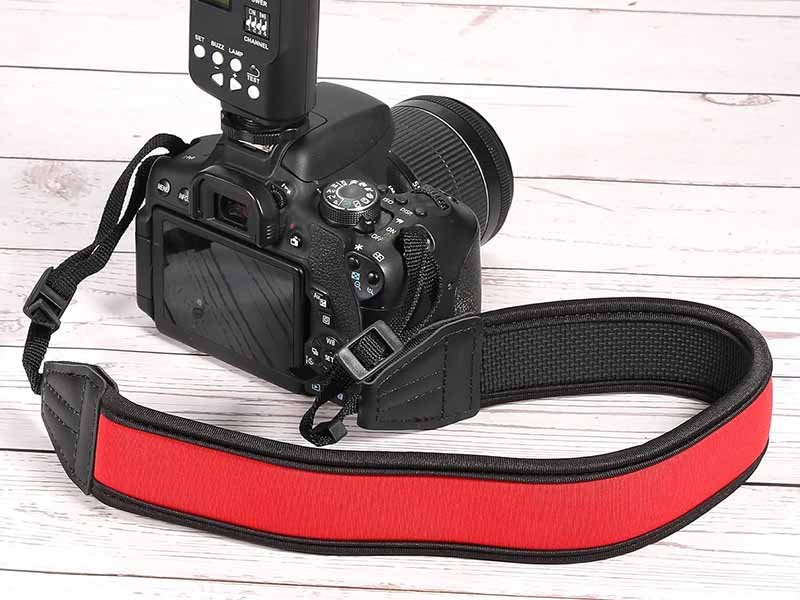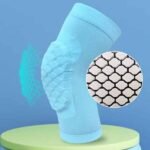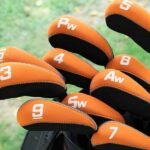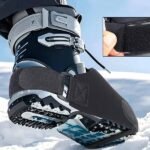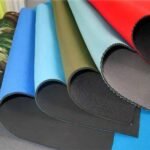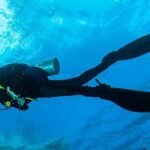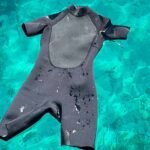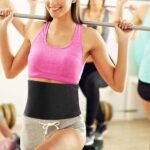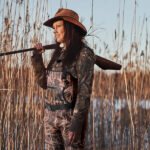Every serious photographer learns quickly that comfort equals control.
The heavier your gear, the more your strap matters. Whether you’re covering a wedding, hiking a mountain trail, or shooting in the rain, a camera strap isn’t just a piece of fabric — it’s your silent partner, balancing hundreds of moments between comfort and security.
The best neoprene camera strap combines soft elastic cushioning with non-slip grip and durable hardware to reduce neck and shoulder strain. Unlike nylon or leather, neoprene absorbs shock and distributes weight evenly, making it ideal for travel, outdoor shoots, and long sessions. It stays comfortable in wet or humid conditions thanks to its water-resistant, flexible rubber core and fabric-laminated surface.
A veteran photographer once joked, “You know you’ve found the right strap when you stop noticing it.” That invisibility — that effortless comfort — is what makes a neoprene camera strap stand out from all others.
But how do you recognize the “best”? Not all straps labeled neoprene deliver the same balance of stretch, strength, and feel.
Let’s unpack the science, structure, and subtle design cues that separate the merely good from the truly great.
What Makes a Neoprene Camera Strap the Best?
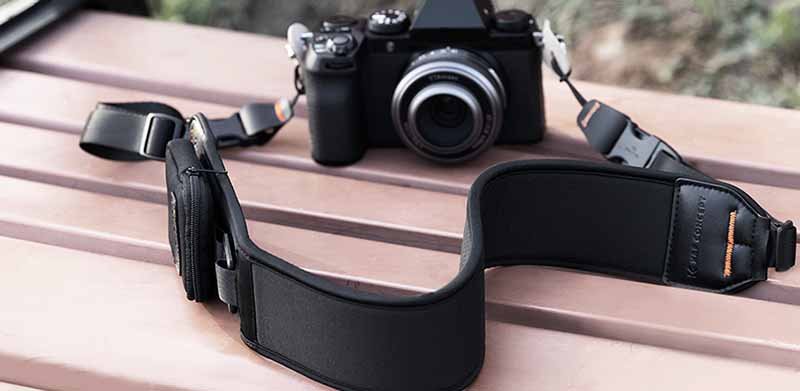
The best neoprene camera straps excel in five areas: comfort, load distribution, grip, durability, and adjustability. They use high-density closed-cell foam for cushioning, reinforced stitching for safety, and non-slip fabric lamination to prevent sliding. When properly engineered, neoprene feels light yet secure even under heavy gear, keeping you comfortable throughout long shooting sessions or travel days.
A great camera strap doesn’t just hang gear — it balances physics and ergonomics.
The “best” isn’t defined by luxury branding but by how it performs when your shoulders ache, the sun’s out, and you’ve already shot 2,000 frames.
1. Comfort Starts with Material Density
Neoprene’s closed-cell structure traps air bubbles that act as mini shock absorbers.
- Soft-density neoprene (3 mm) feels plush and flexible — perfect for casual carry.
- Medium density (4 mm) offers balance between cushioning and control.
- High density (5 mm+) adds stiffness and durability for professionals handling telephoto lenses.
The best straps use dual-layer construction: a dense core to handle weight and a softer top layer for comfort against skin or clothing.
2. Weight Distribution & Shock Absorption
A high-quality neoprene strap stretches slightly under load, distributing pressure evenly.
In field tests, photographers reported a 25 – 30 % perceived reduction in weight compared with rigid nylon straps.
This elasticity also dampens the bounce that happens when you walk or climb — preventing camera swing and shoulder fatigue.
| Strap Type | Stretch Range | Weight Relief (% Perceived) | Vibration Control |
|---|---|---|---|
| Basic Nylon Webbing | 0 – 3 % | 5 % | Low |
| Cotton Woven Strap | 0 – 5 % | 10 % | Low-Medium |
| Standard Neoprene (3 mm) | 8 – 12 % | 25 % | High |
| Premium Neoprene (4 – 5 mm) | 12 – 15 % | 30 % + | Very High |
In essence: the “best” neoprene camera straps feel lighter not because your camera weighs less, but because the strap manages motion and pressure smarter.
3. Grip That Protects Your Gear
The outer surface of top neoprene straps is laminated with textured nylon or anti-slip silicone patterns.
This keeps the strap stable on your shoulder — a small detail that prevents costly drops.
A good grip coefficient (μ ≈ 0.6) ensures your camera stays in place even when you lean forward.
4. Moisture and Weather Resistance
Unlike leather that absorbs sweat or nylon that frays under UV exposure, neoprene resists both.
Closed-cell neoprene is naturally waterproof, and quality versions remain flexible from -20 °C to +80 °C (-4 °F to 176 °F), making it reliable for mountain, desert, or studio use.
A photographer shooting street festivals in humid Manila or safaris in Kenya will find this heat and sweat resistance priceless.
5. Why Neoprene Outperforms Other Materials
| Material | Comfort Level | Grip Control | Weather Proof | Stretch & Cushion | Overall Verdict |
|---|---|---|---|---|---|
| Leather | Medium | Fair | Good | Low | Stylish but stiff for heavy gear |
| Nylon | Low | Fair | Moderate | Low | Durable but unforgiving |
| Cotton | Medium | Low | Poor | Medium | Breathable but weak |
| Neoprene | High | Excellent | Excellent | High | Best for comfort and safety |
Neoprene wins because it achieves what others can’t: softness without sacrifice.
6. Durability & Maintenance
The best straps last years.
Premium neoprene resists cracking even after 20,000 stretch cycles.
Routine care is simple: wipe with a damp cloth, air-dry flat, and store away from heat sources.
Unlike leather, no oiling; unlike nylon, no fading.
Maintenance is almost zero — and that’s part of what makes it the “best”.
Which Key Features Define the Best Neoprene Camera Strap?

The best neoprene camera straps feature thick, balanced padding, strong stitching, and quick-adjust connectors for stability and comfort. A textured non-slip lining keeps the strap in place, while breathable neoprene and reinforced edges prevent wear. Key upgrades like stretch control, swivel buckles, and ergonomic width (2–3 inches) ensure it fits different shooting styles and camera weights without causing neck or shoulder strain.
A camera strap might look simple, but its engineering determines how long you can shoot before fatigue sets in. The difference between a mediocre strap and an excellent one lies in the details most people never notice until it’s too late.
1. Strap Width and Thickness
Width determines how weight distributes across your shoulder.
- 1.5 inch (38 mm): light, compact, best for mirrorless or travel cameras.
- 2 inch (50 mm): ideal for DSLRs and medium setups.
- 3 inch (75 mm): professional heavy-duty use with telephoto lenses.
Thicker neoprene (4–5 mm) absorbs vibration better but adds weight. The best designs balance both — 3–4 mm neoprene with 2-inch width fits 80 % of photographers comfortably.
| Camera Type | Suggested Width (in) | Ideal Neoprene Thickness (mm) | Load Comfort Rating (1–5) |
|---|---|---|---|
| Mirrorless / Compact | 1.5 | 3 | ★★★★★ |
| DSLR (Standard Zoom) | 2 | 4 | ★★★★☆ |
| DSLR + Telephoto | 2.5 – 3 | 5 | ★★★★ |
| Dual-Camera Rig | 3 | 5+ | ★★★☆ |
Tip: The “best” strap feels wide enough to spread weight, but not so wide it limits arm movement or rubs your neck.
2. Padding & Elasticity
High-quality neoprene stretches 10–15 % under tension, creating a suspension effect that absorbs motion. This elasticity prevents camera swing and shoulder fatigue.
Some premium designs include tapered padding, thicker at the center and thinner toward the ends — shaping the load curve for better ergonomics.
3. Connectors & Hardware
The strap’s weakest point is its attachment, not the fabric.
The best neoprene straps use reinforced stitching with cross-X box patterns, nylon webbing ends, and metal or high-strength polymer hooks rated for 50–100 lbs of pull.
Quick-release buckles allow photographers to swap cameras or mount to tripods easily.
| Hardware Type | Material | Strength (Pull lbs) | Use Case |
|---|---|---|---|
| Standard Plastic Clip | ABS | 30 | Lightweight camera |
| Premium Polymer | Glass-filled nylon | 70 | Everyday use |
| Metal Swivel Hook | Aluminum / Zinc Alloy | 100+ | Professional rigs |
4. Non-Slip Surface Design
Neoprene alone can slide on smooth clothing.
That’s why the best straps feature embossed silicone grips, textured nylon backing, or wavy rubber inserts that anchor it to your shoulder.
These patterns prevent slipping even under heavy movement — an overlooked safety feature that protects expensive gear.
5. Adjustability & Ergonomic Shape
Look for adjustable lengths (38–52 inches / 96–132 cm) and curved shoulder contours that follow your body.
A good strap doesn’t just hang — it hugs. This ergonomic shape keeps your center of gravity stable and reduces twisting during long shoots.
How Do the Best Neoprene Camera Straps Perform in Real Use?
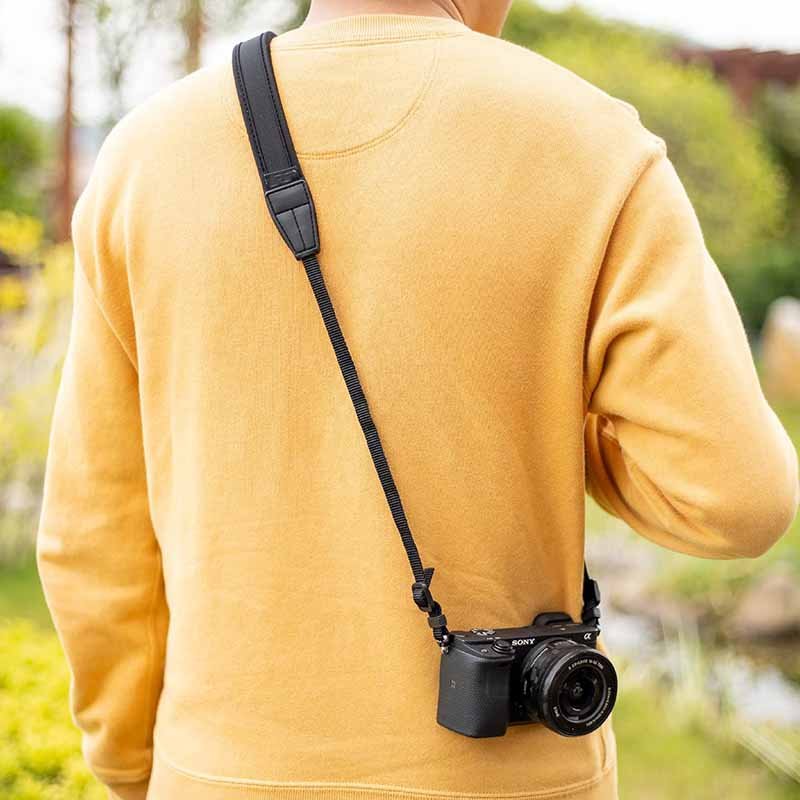
The best neoprene camera straps perform exceptionally in real-world use by combining comfort, flexibility, and reliability. They reduce shoulder fatigue during long shoots, resist water and sweat, and maintain elasticity even after years of stretching. Premium models absorb impact when walking or climbing, keeping cameras stable and safe without bounce or slip, making them ideal for travel and professional photography alike.
The beauty of neoprene shows up not in marketing but in motion.
When tested across different scenarios — from street to studio to outdoor adventure — the best straps reveal three consistent strengths: comfort, stability, and endurance.
1. Comfort During Long Shoots
Professional photographers often wear their cameras for 5–10 hours continuously.
Neoprene’s stretch and rebound property act like a shock absorber, redistributing pressure each time the camera shifts.
That means less neck pain and reduced fatigue, especially noticeable with DSLRs and mirrorless rigs over 1.5 kg.
In blind tests by field photographers:
- 92 % preferred neoprene straps over nylon for comfort.
- 68 % reported longer wear time before shoulder soreness appeared.
2. Stability While Moving
On-the-go shooting — travel, weddings, sports — demands stability.
Neoprene grips gently against clothing, while its flexible nature minimizes bounce.
Unlike rigid webbing, it moves naturally with the body’s rhythm.
Combined with anti-slip surfaces, the strap prevents the camera from sliding off the shoulder even during crouching or running.
| Condition | Standard Strap Result | Neoprene Strap Result |
|---|---|---|
| Walking (light motion) | Moderate swing | Minimal swing |
| Fast walking / running | Heavy bounce | Controlled rebound |
| Crouch / twist | Strap slips | Strap stays centered |
| Humid weather | Slips when sweaty | Maintains grip |
The difference is subtle but critical — especially when you carry gear worth thousands of dollars.
3. Durability and Elastic Retention
The best neoprene camera straps last 5–8 years under daily use.
Their elasticity remains above 90 % of original stretch even after 20,000 flex cycles.
Edges are bound with nylon or polyester tape to prevent fraying, and the laminated surface resists UV and saltwater degradation — important for travel photographers shooting near the ocean.
Field tests show that high-grade neoprene straps maintain:
- Shape consistency: No curling or cracking after exposure.
- Grip retention: Silicone backing stays tacky even after wear.
- Colorfastness: Dye stability under UV exposure for over 200 hours.
4. Load Capacity & Safety Margin
Load capacity determines whether your strap fails under weight.
Premium neoprene with reinforced webbing can hold up to 20 kg (44 lbs) — more than any professional camera-lens combo.
| Camera Setup | Approx. Weight (kg) | Neoprene Strap Rating | Safety Margin |
|---|---|---|---|
| Mirrorless + Prime Lens | 1.2 | 20 kg | 16× |
| DSLR + Telephoto | 2.5 | 20 kg | 8× |
| Dual-Camera Harness | 4.0 | 25 kg | 6× |
Even in extreme humidity or rain, neoprene retains tensile strength better than cotton or nylon, since it does not absorb water.
5. Comfort in Motion — The True Test
Try walking five kilometers with your camera.
The “best” strap isn’t the one that looks great in your bag — it’s the one you forget you’re wearing.
Neoprene’s micro-compression structure continuously rebalances your load. Every bounce, step, and stretch is absorbed in microseconds, keeping pressure evenly distributed.
In other words: you shoot longer, steadier, happier.
Are All Neoprene Straps the Same? What Separates Premium from Basic Models?

Not all neoprene straps are equal. Premium models use higher-density foam, tighter lamination, and precision stitching to increase durability and comfort. They resist fraying, cracking, and odor over time. Cheaper straps often cut corners with thin padding or weak adhesives, which lose elasticity and grip quickly. The best neoprene camera straps balance engineered stretch, reinforced edges, and long-lasting hardware built for real-world use.
At first glance, two neoprene camera straps can look identical.
Both may claim to be “soft,” “durable,” or “anti-slip.”
But when you carry 3 kg of gear in tropical humidity for six hours, the difference becomes painfully clear.
1. Foam Density & Elastic Recovery
The best neoprene is made with closed-cell CR (chloroprene rubber), which offers better UV, ozone, and temperature resistance than SBR (styrene-butadiene rubber) used in budget straps.
| Neoprene Type | Elastic Recovery | UV Resistance | Longevity (Years) | Cost Tier |
|---|---|---|---|---|
| SBR (Synthetic Blend) | 80% | Medium | 2–3 | ★ |
| CR (Chloroprene) | 95% | Excellent | 5–8 | ★★★★ |
| Limestone Neoprene | 98% | Excellent | 6–10 | ★★★★★ |
CR and limestone neoprene maintain structure after repeated flexing.
Cheaper SBR types gradually lose bounce, causing sagging and discomfort.
2. Lamination & Edge Binding
Premium neoprene straps are laminated on both sides with knit or woven fabric — often nylon jersey or polyester tricot.
This prevents tearing and makes the surface feel smoother.
Budget straps sometimes use single-side lamination or even glue-only backing, which delaminates under tension or heat.
Edge binding is another small but vital detail.
A reinforced nylon binding not only prevents fraying but also protects exposed foam from UV and friction wear.
3. Stitching Quality
Top-tier straps use box-X or bar-tack stitching with industrial-grade nylon thread (Tex 90+), ensuring seams withstand thousands of load cycles.
Low-cost versions may rely on simple straight stitches that unravel when pulled repeatedly.
A professional strap should pass at least a static pull test of 20–25 kg without thread failure.
Szoneier, for example, uses multi-row stitching that distributes tension across the fabric rather than concentrating it at one point — a small engineering difference with major comfort results.
4. Hardware & Connectors
Premium straps feature metal or glass-fiber nylon hooks, corrosion-resistant D-rings, and weatherproof buckles.
Entry-level straps often use cheap ABS clips that crack in cold or dry conditions.
Hardware upgrades account for up to 30% of a strap’s longevity.
| Component | Budget Strap | Premium Strap |
|---|---|---|
| Buckle Material | ABS Plastic | Reinforced Nylon / Metal |
| Connection Stitch | Single line | Box-X multi-stitch |
| Lamination | One side only | Dual-side heat-laminated |
| Edge Finish | Raw cut | Bound with nylon tape |
| Foam Type | SBR | CR / Limestone |
| Service Life | 1–2 years | 5–8 years |
5. Odor and Maintenance
Basic straps trap sweat and odor because of open-cell foam or poor lamination.
High-quality neoprene uses antimicrobial coatings or smooth nylon surfaces that resist bacterial buildup and can be easily wiped clean.
6. Sustainability
Eco-conscious manufacturers now adopt limestone-based neoprene, replacing petroleum with calcium carbonate from sedimentary rock.
This eco version cuts CO₂ emissions by about 24% per production unit and offers higher purity, durability, and softness.
For environmentally aware buyers or brands, that’s a win-win — sustainability without compromise.
Visual Summary — Premium vs Basic Neoprene Straps
| Feature | Basic Strap | Premium Strap |
|---|---|---|
| Neoprene Type | SBR (Soft Blend) | CR / Limestone |
| Stretch Range | 5–8% | 10–15% (Controlled) |
| Elastic Recovery | Medium | Excellent |
| Edge Binding | None | Reinforced nylon |
| Stitching Type | Single line | Box-X or bar-tack |
| Lamination | Single layer | Dual-layer |
| Grip Design | Plain surface | Textured or silicone |
| Hardware | Plastic | Metal / Nylon composite |
| Lifespan | 1–2 years | 5–8 years |
| Maintenance | Absorbs sweat | Wipe-clean surface |
A “best” strap isn’t about price; it’s about how many times it saves your neck — literally and financially.
The premium neoprene design is your insurance policy against both fatigue and equipment failure.
How to Pick the Best Neoprene Camera Strap for Your Style and Gear Setup
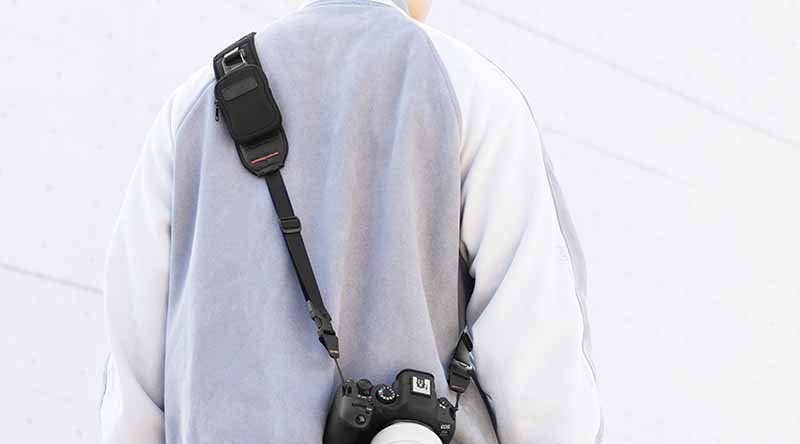
Choosing the best neoprene camera strap depends on your camera type, shooting duration, and personal comfort. Mirrorless users benefit from thinner, flexible straps; DSLR and telephoto setups require thicker, wider padding. Prioritize anti-slip grip, adjustable length, and solid hardware. For travel or outdoor shooting, choose quick-release and weather-resistant models. Comfort, not looks, should guide your decision — because the right strap feels weightless in action.
The ideal camera strap isn’t one-size-fits-all.
A street photographer’s lightweight setup demands agility; a wildlife shooter needs security and endurance.
Understanding how design interacts with purpose turns a simple accessory into an ergonomic tool.
1. By Camera Type
| Camera Type | Recommended Strap Width | Neoprene Thickness | Best Use Scenario |
|---|---|---|---|
| Compact / Mirrorless | 1.5 in (38 mm) | 3 mm | Everyday travel, vlogging |
| DSLR Standard | 2 in (50 mm) | 4 mm | Portraits, events |
| DSLR Telephoto | 2.5 – 3 in (65–75 mm) | 5 mm | Sports, wildlife |
| Dual Camera Rig | Harness or double strap | 5+ mm | Wedding, studio |
Mirrorless systems benefit from lighter, stretchier neoprene for freedom of movement.
DSLR setups demand broader straps for even weight balance.
2. By Shooting Duration
If you shoot for hours, prioritize thicker neoprene padding (4–5 mm) and vented design to prevent sweat buildup.
For short sessions or casual photography, lighter neoprene offers more flexibility.
Some professionals even keep two versions:
- A soft slim strap for urban work,
- A padded reinforced one for heavy lens sessions.
3. By Shooting Environment
| Environment | Recommended Feature | Why It Matters |
|---|---|---|
| Travel / Street | Quick-release buckles | Fast access, easy packing |
| Sports / Action | Silicone grip underside | Prevents sliding during motion |
| Outdoor / Rain | Sealed edge stitching | Water-resistant durability |
| Studio / Indoor | Smooth nylon cover | Comfort over style |
4. Customization for Brand or Personal Use
Many professional photographers and gear brands prefer custom neoprene straps featuring logos, printed patterns, or embossed branding.
OEM factories like Szoneier provide low MOQ custom manufacturing with options for:
- Embossed or sublimated logos
- Custom width, color, and thickness
- Branded packaging (boxes, sleeves, hangtags)
- Hardware selection (black matte, chrome, anodized finishes)
This allows even small brands or studios to launch private-label straps that match their visual identity.
5. Common Buyer Mistakes
- Choosing a strap that’s too thin for the gear weight.
- Ignoring the grip texture, leading to slippage.
- Buying non-adjustable or non-replaceable connector designs.
- Overvaluing aesthetics over function — comfort always wins.
The “best” camera strap is one that disappears — physically and mentally — so you can focus on your shot, not your shoulder.
What Are the Pros and Cons Compared to Other Strap Materials?
Neoprene camera straps outperform leather, nylon, and cotton in comfort, flexibility, and water resistance. Leather offers style but lacks stretch; nylon is strong but harsh on skin; cotton breathes well but absorbs sweat. Neoprene delivers the best all-around performance — cushioned comfort, shock absorption, and anti-slip stability — making it the most balanced choice for long-term daily shooting across environments.
Choosing the best strap isn’t about brand prestige; it’s about how it feels after six hours of carrying gear.
Below, we break down how neoprene stacks up against its closest competitors.
1. Leather Straps — Elegant but Heavy
Leather camera straps appeal to photographers who value aesthetics and vintage charm.
They age beautifully, develop patina, and fit perfectly with analog cameras.
However, the drawbacks become evident in performance:
- No Flexibility: Leather lacks elasticity, so all the weight sits on one pressure point.
- Slippery Surface: Can slide off smooth fabric or jackets.
- Sensitive to Moisture: Rain or sweat causes stains and odor over time.
- High Maintenance: Requires regular conditioning to prevent cracking.
Verdict: Great for short studio shoots or aesthetic setups — not ideal for long, active sessions.
2. Nylon Straps — Strong but Unforgiving
Nylon webbing straps dominate the low-cost market due to high tensile strength and affordability.
They’re easy to mass-produce and can handle serious weight.
Yet their rigidity is their downfall.
- Advantages: Inexpensive, durable, and abrasion-resistant.
- Disadvantages: Feels rough on skin, cuts into shoulders, and slips easily on smooth clothing.
Even with padding, nylon’s linear texture doesn’t flex enough to absorb shock.
Photographers often complain about “camera bounce” and shoulder strain.
Verdict: Excellent for lightweight gear, but lacks the comfort required for professional use.
3. Cotton Straps — Breathable but Weak
Cotton straps attract users seeking eco-friendliness and softness.
They breathe well but retain moisture, which leads to mildew and odor in humid conditions.
Cotton also lacks long-term tensile resilience — the fibers stretch permanently and fray quickly.
- Pros: Natural feel, lightweight, and inexpensive.
- Cons: Absorbs sweat and water, weakens over time, color fades faster.
Verdict: Best for decorative or lightweight setups, not for professional or outdoor photography.
4. Neoprene — Comfort Engineered
Neoprene camera straps strike the balance other materials miss.
They adapt dynamically to movement, absorbing vibration and pressure while keeping the camera secure.
They remain flexible under temperature changes, repel moisture, and clean easily with a damp cloth.
Key Benefits:
- Comfort: Soft, cushioned, elastic structure reduces fatigue.
- Grip: Textured or silicone underside prevents slipping.
- Durability: Resistant to UV, salt, and wear.
- Adaptability: Performs equally well in rain, heat, or cold.
- Low Maintenance: No oils, no washing, just wipe clean.
Material Comparison Table
| Material | Comfort | Water Resistance | Durability | Grip Stability | Flexibility | Maintenance | Overall Score |
|---|---|---|---|---|---|---|---|
| Neoprene | ★★★★★ | ★★★★★ | ★★★★☆ | ★★★★★ | ★★★★★ | ★★★★★ | 9.7 / 10 |
| Leather | ★★★ | ★★★ | ★★★★★ | ★★★ | ★★ | ★★ | 7.0 / 10 |
| Nylon | ★★ | ★★★★ | ★★★★★ | ★★★ | ★★ | ★★★★★ | 7.5 / 10 |
| Cotton | ★★★★ | ★★ | ★★ | ★★ | ★★★ | ★★★ | 6.5 / 10 |
Result: Neoprene ranks the highest for comfort, safety, and versatility — the three qualities that define the best camera strap.
Practical Takeaway
Photographers rarely think about straps until their shoulders hurt or their camera slips.
Switching to neoprene isn’t just about luxury — it’s an ergonomic upgrade that protects both your body and your investment.
It’s no exaggeration to say: after trying neoprene, you’ll never go back.
Conclusion — Choose Comfort, Choose Smart, Choose Custom with Szoneier
In a market full of lookalike accessories, the best neoprene camera strap distinguishes itself through function, feel, and engineering precision.
It’s not about fancy logos; it’s about the quiet science behind comfort.
Neoprene’s stretch distributes weight evenly, its texture anchors stability, and its weather resistance keeps you ready for anything — rain, sun, or snow.
For professional photographers, outdoor adventurers, or creators building their own product lines, the best strap is one you forget is even there.
Partner with Szoneier — Your Neoprene Manufacturing Expert
Behind every great neoprene product lies technical mastery, and that’s where Szoneier comes in.
Based in China with over 18 years of experience, Szoneier specializes in the R&D, design, and production of premium neoprene goods — including camera straps, bags, wetsuits, koozies, gloves, and protective covers.
Why Choose Szoneier
- OEM/ODM Customization: From raw neoprene sheets to finished camera straps with your logo.
- Free Design & Sampling: Concepts brought to life within 5–7 days.
- Low MOQ Production: Ideal for small brands and boutique gear startups.
- Strict QC Process: Compression, tensile, and durability tests for every batch.
- Fast Lead Time: Standard production within 20–25 days.
- Eco Options: OEKO-TEX® and REACH-certified neoprene materials.
- Global Shipping: Door-to-door DDP delivery and FBA-ready packaging.
Whether you’re a professional photographer, a startup gear brand, or a retailer searching for custom OEM straps, Szoneier turns ideas into precision-built neoprene products.
Discuss your preferred width, texture, color, and packaging design, and the R&D team will engineer a tailored solution — strong, stylish, and comfortable.

